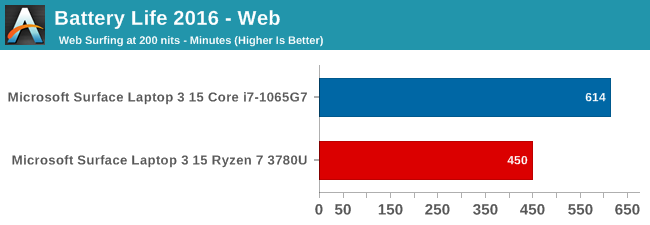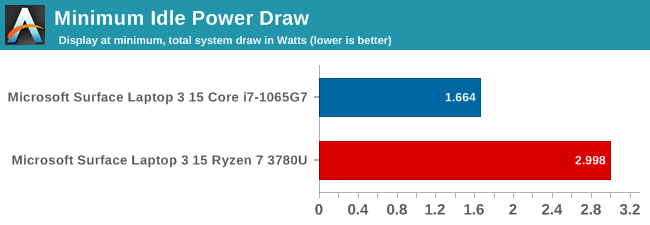The Microsoft Surface Laptop 3 Showdown: AMD's Ryzen Picasso vs. Intel's Ice Lake
by Brett Howse & Andrei Frumusanu on December 13, 2019 8:30 AM ESTPlatform Power
Performance aside, the other side of the coin is battery life. AMD made big gains in battery life with the Ryzen 3000 series, somewhat addressing the power requirements of the platform and getting rid of some of the excessive idle power draw, but they are still using DDR4 on their mobile platform, which puts them at a disadvantage right out of the gate. Intel has made very good gains in battery life over the last several generations, and the move to 10 nm for Ice Lake also brought along LPDDR4X support. Most of the previous generation laptops stuck with LPDDR3, unless the manufacturer needed more than 16 GB of RAM, where they’d be forced to switch to DDR4. Finally adding LPDDR4X support is something that Intel has needed to do for a while, and ironically Intel’s flagship Core product line lagged behind their low-cost Atom lineup which did support LPDDR4.
Web Battery Life

The Ryzen 7 3780U powered Surface Laptop 3 was slightly under the Ryzen 5 device we tested at launch, but still in the same range. The AMD system isn’t helped very much by Microsoft only offering a 46 Wh nominal battery capacity, which is rather undersized for a 15-inch laptop. The Ice Lake device, as we’ve seen before, was much more efficient under load, offering a sizeable battery life lead.
Idle Power
One of AMD’s biggest challenges was to get their laptop SoC into a premium device, and with the Surface Laptop 3 they have succeeded. Microsoft has shown themselves as being adept at squeezing battery life out of devices, with low-power displays, and good internal components to minimize power draw. Here Intel has held a considerable advantage over the last couple of years, and the move to 10 nm should, in theory, help as well.
To test the idle power draw of both systems, the battery discharge rate was monitored with the screens fixed in at 5.35 nits, to minimize the power draw of the display on the result. Normally we’d prefer to have the display completely off for this test, but Microsoft’s power plan on the Surface Laptop actively turns off the laptop when the display times out.

The Ice Lake system was able to go all the way down to right around 2 Watts of power draw – and sometimes slightly under – with as low as 1.7 Watts seen. We’ve seen under 1 Watt of draw on an 8th generation Core Y series processor, and around 1.5 Watts on the same generation U series, so considering the display is not completely off on the Surface Laptop, the 2-Watt draw is quite reasonable.
The Picasso system was not quite as efficient, drawing 3 Watts at idle. This is in-line with the results we’ve seen on other Picasso systems and explains the lower battery life results on the AMD system. AMD made big gains moving from Raven Ridge to Picasso, but I’m sure the team is looking forward to the 7 nm Zen 2 coming to their laptops, which we hope will address this further.










174 Comments
View All Comments
m53 - Saturday, December 14, 2019 - link
@Samus: It is sad that some people would buy the inferior Ryzen 15inch without even knowing that there is a better Intel 15inch version available and you don’t have be a business person to buy it. Pathetic anti-consumer attempt from Microsoft.0ldman79 - Tuesday, December 17, 2019 - link
Pretty sure it's because Intel is having issues supplying the chips to the OEMs.Microsoft, like most OEM, are hedging their bets and designing systems to run AMD chips.
MBarton - Monday, December 30, 2019 - link
It's sad that anyone would buy an overpriced Microsoft Surface.MBarton - Monday, December 30, 2019 - link
Because Intel 10nm yields are so woefully pathetic that Microsoft had to source AMD's old Zen parts to help make up for the lack of parts.Polacott - Saturday, December 14, 2019 - link
I guess for some people, the extra cpu processing power is not needed however the extra storage can be a handy thing? processors are quite powerful these days. Of course for me I would choose higher processing speed over storage, if it were for my mother i would choose storage over speed.Brett Howse - Saturday, December 14, 2019 - link
You can get the same storage in both.Polacott - Sunday, December 15, 2019 - link
For the dame money?Brett Howse - Sunday, December 15, 2019 - link
The business model with Intel is $100 more but comes with Windows 10 Pro which is a $100 upgrade over home, so for the hardware, it's the same money, but the business version is overall $100 more expensive.m53 - Sunday, December 15, 2019 - link
@Brett: Agreed. In addition it comes with a better and more expensive ram. so the intel version is not just insanely faster, it is also the better value overall.Polacott - Saturday, December 14, 2019 - link
Considering Microsoft is just giving Windows Home in AMD offer and Pro + better ram on Intel one, they must be getting the intel cpu at a tremendously affordable price or up pricing the AMD offer considerably.